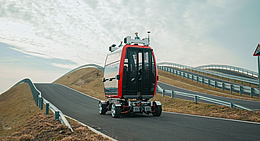MARKETING FOR KIDS
Extend your reality!
How XR, AR, VR and MR will change the travel experience of the future.
Forget about the metaverse! Or rather, park it in the back of your mind for as long as it takes you to read this article. We won't really need it, because the metaverse is not going to exist in the form heralded and described in such glowing terms by Marc Zuckerberg, with really practical benefits for tourism, any time soon. What we do have now, however, and what is set to become part of our lives very soon – perhaps more quickly than we would like – are other forms of extended reality (XR). Extended reality (XR) is an umbrella term covering various technologies that blur the distinction between the physical world and the virtual world. XR combines three main forms of immersive technology: virtual reality (VR), augmented reality (AR) and mixed reality (MR). Each of these technologies offers a unique experience that revolutionizes how we perceive the world and how guests will consume their travel experiences.
Let’s start by taking a look at these three main concepts:
1. Virtual reality (VR): Virtual reality is a technology that transfers the user into a completely artificial, virtual environment. (So we are briefly encountering the metaverse after all.) It involves the use of dedicated VR headsets or goggles to fully capture the user's visual and sometimes auditory perception. This results in the user feeling completely immersed in a computer-generated world. VR is employed primarily in the gaming industry, but also in such areas as education, training, medicine and architecture to provide realistic simulations and experiences.
2. Augmented reality (AR): In contrast to VR, augmented reality adds digital content to the physical world. Computer-generated elements are integrated into the user's field of vision and combined with the real environment. AR is commonly used on smartphones or tablets and has many applications, from simple entertainment apps to complex industrial applications. A well known example of AR is the popular game Pokémon GO, in which virtual Pokémon are projected into the real world.
3. Mixed reality (MR): Mixed reality is a further development of AR, which merges virtual content seamlessly with the real environment. Unlike AR, however, the virtual objects in MR interact dynamically and realistically with the physical world. The technology recognizes the environment and adapts the virtual objects accordingly.
Extended reality has the potential to impact many fields of life, including tourism. With the development of increasingly powerful devices and advanced software, XR is becoming more accessible and offers endless opportunities for innovation. In the future, we could see a fusion of the physical and virtual worlds, with XR as an integral part of our everyday lives. We already call Generation Alpha, i.e. children born between about 2010 and 2025, “virtual natives”; they are the first generation to grow up with virtual and augmented reality. For them, it is all normal, and we have to adapt to this generation and their technology mindset in tourism as well.
In the future, XR will play an even greater role in tourism and will further enhance the travel experience for our guests. Here are some ways XR might be applied in the tourism industry in the years ahead. Many of these applications are already being used today in gaming environments, for example.
1. Virtual travel planning: Tourists could make use of XR technologies to virtually explore potential destinations in advance. Through immersive VR “visits”, they could assess various mountain experiences, hotels, attractions, and activities and so make better informed decisions for their trip.
2. Augmented reality as a travel companion: AR applications could be employed by visitors on their trip to display useful information about sights, restaurants, stores and public transport. They could use their smartphones or AR glasses to find their way around and receive local insider tips.
3. Virtual tourist attractions: With guests able to experience virtual attractions in a mix of AR and VR, it would be possible to reduce visitor numbers and manage crowds at popular locations in the real world.
4. Personalized travel experiences: XR can be used to offer personalized travel experiences that match visitors’ individual interests and preferences. Based on VR profiles and user data, tour operators could create customized tours and activities tailored to visitors’ specific needs and ideas.
5. Cultural and historical interaction: XR can help bring historical events and cultural traditions to life. A virtual tour of a mountain, for example, would allow guests to experience its beauty at different times of the year or to see how the mountains were managed in times gone by. This would help them achieve a deeper understanding of the region.
6. Interactive travel experiences / story living: XR can make the travel experience more interactive through full immersion in stories. For example, guests could participate in a virtual tour or scavenger hunt in a mountain experience world.
7. Sustainable tourism: XR could help reduce the environmental footprint of tourism by promoting virtual travel experiences. Instead of physically traveling to certain places, guests could visit them virtually and so minimize the environmental impact. Perhaps people will pay for such experiences in the future.
These examples illustrate the immense potential of XR in tourism and show how the technology could transform the travel experience of the future. By integrating XR applications, guests can discover the region in new and exciting ways while benefiting from personalized, interactive and sustainable travel experiences.
You want to benefit from the new technology right now? We have developed an interactive puzzle rally that brings mountain experiences to life with AR. You can use it to design a new mountain discovery trail or upgrade an existing one. More info from: office@kidsandfunconsulting.com.

(Photo / Visual: Bernhard Döller)
![[Translate to English:] Foto: Leitner](/fileadmin/_processed_/a/8/csm_Vertragsunterzeichnung_Narvik_6_copyright_LEITNER_print_501f2d5c24.jpg)


![[Translate to English:] (c) Doppelmayr](/fileadmin/_processed_/b/3/csm_85-ATW_Stechelberg-Muerren_Lauterbrunnen_CHE_001_6442c0520d.jpg)







